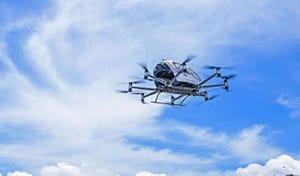Chinese Researchers Develop Mind-Controllable Metasurface
Bluetooth-enabled sensor uses brainwaves to control scattering patterns on programmable metasurface

They haven’t bent any spoons yet, but a team of Chinese scientists has developed a telekinetic technology that allows a person to remotely control a metasurface with their mind.
The platform, developed by a team from China’s Air Force Engineering University, the Shanghai Jiao Tong University and the National University of Singapore, uses a person’s brain waves to wirelessly control a programmable metasurface using Bluetooth. What makes the team’s approach unique is that unlike previous experiments that required a direct, wired connection to the metasurface, the subject is able to manipulate it remotely.
“Different from the traditional dynamic metasurface, this metasurface could manipulate the [electromagnetic (EM)] wave through the real-time response of the human brain, rather than manual operation,” the team writes in their paper, “Remotely mind-controlled metasurface via brainwaves,” which was published in the optics journal eLight. “Our design maps the thinking of the human brain into metasurface EM modulation, which effectively increases the rate of EM modulation.”
The telekinetic platform consists of three components: A sensor to record the brainwaves and transmit them via Bluetooth, a controller to receive and convert them into “attention signals,” and the programmable metasurface. (Metasurfaces are the two-dimensional counterparts of metamaterials, which are engineered to have properties not found in nature. Those properties are derived from the metamaterials’ newly designed structures and not from the base materials they are made of.)
More specifically, the platform’s sensor consists of a commercially available brain wave extraction module that uses an electroencephalo-graph (EEG) sensor to record the subject’s brain waves, which are detected by electrodes attached to the head. These delta, theta, alpha, beta and gamma waves, which represent the different frequencies of brainwave activity, are extracted and converted to attention intensity through a built-in algorithm that classifies it by four threshold intervals — distracted, neutral, concentrated and extremely concentrated — based on the subject’s level of attention. The sensor then transmits these values to the controller using Bluetooth.
The controller, which consists of a microprogrammed control unit (MCU) and output terminal, takes the attention values, which correspond to different coding sequences, and sends them to the programmable metasurface, where they are displayed as different scattering patterns. The user can thereby control the scattering patterns on the metasurface by altering their attention concentration through their thoughts.
Looking ahead, the team believes the successful demonstration of its prototype metasurface system “paves a new way to intelligent metasurfaces,” with possible applications in health monitoring, 5G/6G communications, smart sensors and more.
“If we can collect brainwaves and use them as the control signals of metasurfaces, we can not only allow the users to control metasurfaces with their mind, but also can improve the response rate of metasurfaces,” they say. “This will make a big step towards truly intelligent metasurfaces.”
About the Author
You May Also Like








